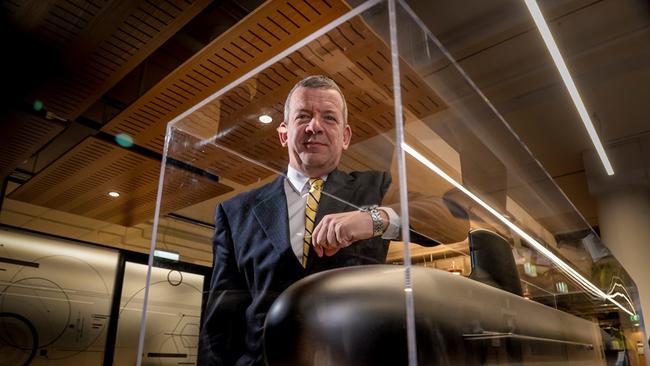For subs’ builder, the task ahead is historic
The chief executive of future-submarines builder Naval Group Australia, John Davis, says the project ‘will transform Australia’.

To John Davis, heading Naval Group Australia and its Future Submarine construction program is a career dream realised.
Davis, 53, confesses to what he terms a complete love of submarines — “I have spent a large proportion of my career working on submarines. They are technically challenging, complex and demanding platforms that are critical to the nation’s defence.”
Born and raised in London, Davis is an Australian and British dual national who moved to Adelaide in 2007 — to take up a senior position on the Air Warfare Destroyer program.
His ultimate goal was to help lead the design for a conventional submarine, and his appointment last July as chief executive and Future Submarine program director of Naval Group Australia “was a career dream come true and a great privilege”.
Davis is under no illusions about the significance of the $50 billion Sea 1000 program and his own crucial role in progressing the design and construction of 12 regionally-superior Attack-class submarines to replace the Royal Australian Navy’s six-strong Collins-class fleet.
“The enormity of the program is on a scale unlike anything our nation has ever seen. It will transform Australia,” he says.
“For me it presents a unique opportunity to use the experience I have gained over the past 30 years in naval design, build and sustainment programs to help establish a truly sovereign submarine capability,” he says.
That experience, primarily gained working with nuclear submarines, encompassed 14 years with the UK Ministry of Defence (MoD) Procurement Executive.
His roles there included technical and project management for Resolution-class ballistic-missile submarine operational support, updates to Swiftsure and Trafalgar-class nuclear-powered fleet submarines, build and test of Upholder-class (now Canadian Victoria-class) diesel-electric attack submarines, and the Royal Navy’s Tomahawk cruise-missile project.
Davis was later appointed the functional head of platform and combat system design departments within the joint MoD-industry Submarine Support Management Group.
There he was responsible for safety, availability, capability and quality standards in design work undertaken by the SSMG in support of Swiftsure and Trafalgar boats as well as nuclear-powered Vanguard-class ballistic-missile submarines.
Six years with BMT Defence Services Ltd as executive director in the company’s submarine and warship design and support subsidiary was followed by Davis’s arrival in Adelaide in 2007 and senior roles with Raytheon Australia on the AWD design and build program.
Nearly a year after joining Naval Group Australia, the first few months of which were at the tail end of challenging negotiations with the federal government on a Strategic Partnering Agreement, Davis says company-government relations are good.
Thanks to a unique Framework Agreement between the France-based Naval Group and the federal-government-owned ASC aimed at achieving long-term sustainable capability for both the Future Submarine program and the in-service Collin-class fleet, what he describes as a genuine team spirit on both sides is contributing to renewed industry evolution.
Naval Group Australia’s 100-strong Adelaide workforce, including the 25-strong French program management, procurement and supply-chain and engineering specialists, is expected to double in size by the end of 2019, Davis says.
“They have very good English and we are steadily improving our French,” he says. In Cherbourg, 19 Naval Group Australia engineers are working and learning side-by-side with French colleagues, gaining specific submarine-design expertise with which to instruct the future workforce on their return home.
Davis acknowledges that cultural differences and similarities exist in any situation where people from different backgrounds work together, but says cultural diversity brings with it many benefits to large and complex projects, including creativity, innovation, adaptability and productivity.
Ensuring a safe working environment when program work moves to the submarine construction yard is another priority.
That facility is being built on about 40 hectares of land at the Osborne North naval shipyard on the outskirts of Adelaide and the scale of equipment will be unique within Australia, Davis says.
When submarine construction begins there in 2023, the facility will be capable of shaping the steel for a submarine’s hull, welding the hull components together, machining the hull sections and assembling the completed boat.
Away from the office, weekends in Adelaide for Davis involve activities that keep him fit, and house renovations and a growing list of chores. When time allows he’s also a keen “but not proficient” fisherman.


